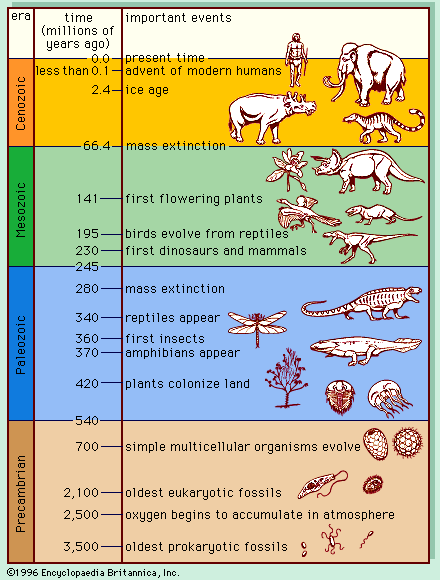
Life is a the state of a material complex or individual characterized by the capacity to perform certain functional activities, including metabolism, growth, reproduction, and some form of responsiveness and adaptation. Life is further characterized by the presence of complex transformations of organic molecules, and by the organization of such molecules into the successively larger units of protoplasm, cells, organs, and organisms.
Metabolism involves a living system's continual exchange of some of its materials with its surroundings, principally in the process of building up or destroying its protoplasm. Growth involves an increase in the size of an organism, which in turn is usually due to its having a higher metabolic rate of synthesis of protoplasm than a rate of breakdown of that matter. Reproduction, perhaps the most striking hallmark of life, involves at its most basic level the division of one cell into two cells. This process is ultimately mediated by the hereditary information contained in large molecules, called genes, that are composed of nucleic acids. The reproduction of genes themselves passes the instructions for the various characteristics of an organism on to the next generation. Responsiveness and adaptation represent the ability of an organism to change in response to alterations in its environment. These two qualities are fundamental determinants of the process of natural selection, through which the hereditary characteristics of organisms evolve over long periods of time and many generations.
Opinion concerning the essential nature of life has been historically divided between vitalist and mechanistic concepts. Vitalism asserts the existence of some "vital force" that separates living from nonliving matter and forms life's underlying principle. Mechanism, on the other hand, asserts that the wondrous phenomena of life are merely processes and transformations obeying elementary chemical and physical laws, and that a living system is ultimately reducible to its constituent atoms and molecules, and nothing more.
Procaryotic bacteria and blue-green algae are the earliest known forms of life on Earth. Fossils of these organisms, discovered in the Fig Tree chert of the Transvaal, have been dated at 3.5 billion years old. This suggests that living systems appeared within a few hundred million years after the origin of their host planet, since the Earth itself is thought to be about 4.6 billion years old.

Hypotheses of the origin of life range from religious concepts of life's creation out of inanimate matter by a divine agency to the more scientifically acceptable theory that life began on the early Earth by a series of progressive chemical reactions. According to this hypothesis, which has been supported by recent laboratory experimentation, inorganic compounds such as methane, ammonia, and water vapour that were plentiful in early times on the Earth formed into simple organic molecules with the aid of atmospheric electric discharges and ultraviolet radiation as energy sources. The question of how the resulting simple amino acids eventually became the much more highly organized and self-replicating systems known as life is much more difficult to answer, however, and is still far from being resolved.
Excerpt from the Encyclopedia Britannica without permission.